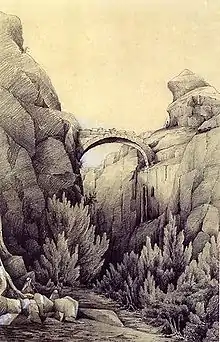Lady Louisa Tenison (c. 1820[1] - 27 Aug 1882[2]) was an English artist, traveler and author.
Biography
Lady Louisa Mary Anne Anson (later Tenison) was the daughter of Thomas Anson, 1st Earl of Lichfield and his wife Louisa Catherine Philips, the eldest of their 8 children.[3]
She married Lt. Col Edward King-Tenison on 26 Nov 1838.[2] They had two daughters, Louisa Frances Mary and Florence Margaret Christina.[4] Her husband was an MP and in the 1840s became intensely interested in the emerging practice of photography.[4]

She and her husband traveled through Egypt, Palestine and Syria in 1843, which led her to create a series of drawings of sites such as Karnak, Petra and the Church of the Holy Sepulchre, later published in her book Sketches in the East.[5] Several years later, she documented their tour of Spain in her work Castile and Andalucia, which she wrote and also co-illustrated along with painter Egron Lundgren.[6] She also assisted James Uwins (nephew of Thomas Uwins RA) with his drawings of the city of Granada, which were the source for paintings by Robert Burford exhibited at the Leicester Square Panorama in 1853.[7]
She lived with her husband at Kilronan Castle, Co Roscommon - a family estate which she and her husband significantly enlarged in the 1870s.[8] She took an active role in the building works, notably dismissing the builder Sir Thomas Newenham Deane after a disagreement over cost overruns.[9] She died in Trieste on 27 Aug 1882.[10]
In art and literature
Her portrait by John Phillip is part of the collection of the Royal Scottish Academy of Art & Architecture.[11]
A book entitled The Book of Fenagh or of St. Caillin was dedicated to her, recognising her commitment both to "the land of her adoption" as well as her knowledge of the Celtic language.[12] She and her husband supported the translation of the book and also supplied early photographs of Fenagh.[13]
One of her watercolour paintings featured in Sketches in the East, depicting the House of the British consul in Damascus, resides in the UK government art collection.[14] In the book, she describes this room as being "one of the most splendid in Damascus."[15]
References
- ↑ "Bonhams : Tenison (Louisa) Sketches in the East... Drawn on Stone, First Edition, Dickinson & Son, 1846". www.bonhams.com. Retrieved 20 November 2022.
- 1 2 Burke's Peerage 2003.
- ↑ Cockayne 2000, p. 2325.
- 1 2 Slattery, Peadar. "Tenison, Edward King". Dictionary of Irish Biography. Retrieved 20 November 2022.
- ↑ Tenison 1846.
- ↑ Tenison 1853.
- ↑ Granada 1853.
- ↑ "History Of Kilronan Castle". Kilronan Castle Estate & Spa. Retrieved 20 November 2022.
- ↑ "Lady Louisa Mary Anne Tenison". Dictionary of Irish Architects.
- ↑ "Lady Louisa Mary Anne Tenison". Government Art Collection. Retrieved 20 November 2022.
- ↑ "Lady Louisa Tennyson". Art UK. Retrieved 20 November 2022.
- ↑ The Book of Fenagh 1875, p. a2.
- ↑ "Book of Fenagh 500th Anniversary". Royal Irish Academy. 24 May 2016. Retrieved 20 November 2022.
- ↑ "Lady Louisa Mary Anne Tenison". Government Art Collection. Retrieved 20 November 2022.
- ↑ Tenison 1846, p. 3.
Sources
- The Book of Fenagh (PDF). Dublin: Alexander Thom. 1875.
- Burke's Peerage, Baronetage and Knightage (107th ed.). Stokesley: Burke's Peerage & Gentry. 2003. ISBN 9780971196629.
- Cockayne, George E. (2000). The Complete Peerage of England, Scotland, Ireland, Great Britain and the United Kingdom, Extant, Extinct, or Dormant. Gloucester: Alan Sutton Publishing.
- Description of a View of the City of Granada, With the Celebrated Fortress and Palace of the Alhambra, and the Surrounding Beautiful Vega, or Plain. London: R. Burford. 1853.
- Tenison, Louisa (1853). Castile and Andalucia. London: R. Bentley.
- Tenison, Louisa (1846). Sketches in the East by Lady Louisa Tenison. Drawn on Stone by Dickinson & Son. [Comprising Views in Egypt, Arabia, Petra & Syria]. London.